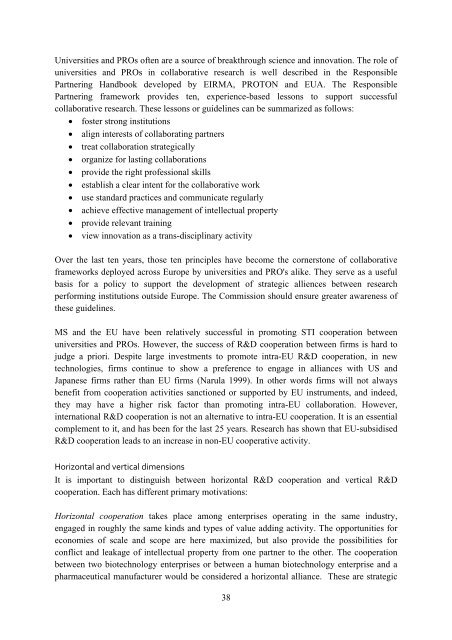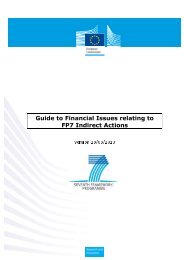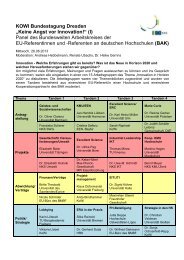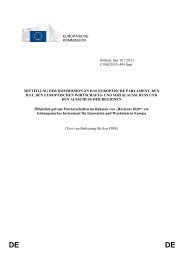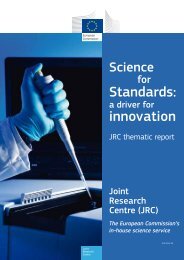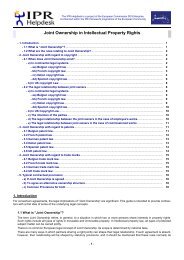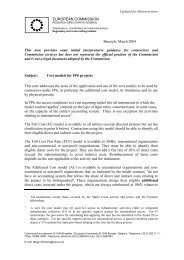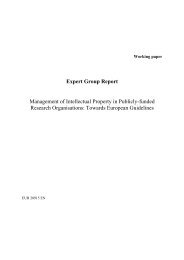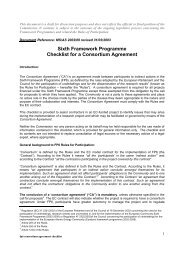Draft Report of the Expert Group on International STI Cooperation to ...
Draft Report of the Expert Group on International STI Cooperation to ...
Draft Report of the Expert Group on International STI Cooperation to ...
You also want an ePaper? Increase the reach of your titles
YUMPU automatically turns print PDFs into web optimized ePapers that Google loves.
Universities and PROs <str<strong>on</strong>g>of</str<strong>on</strong>g>ten are a source <str<strong>on</strong>g>of</str<strong>on</strong>g> breakthrough science and innovati<strong>on</strong>. The role <str<strong>on</strong>g>of</str<strong>on</strong>g><br />
universities and PROs in collaborative research is well described in <str<strong>on</strong>g>the</str<strong>on</strong>g> Resp<strong>on</strong>sible<br />
Partnering Handbook developed by EIRMA, PROTON and EUA. The Resp<strong>on</strong>sible<br />
Partnering framework provides ten, experience-based less<strong>on</strong>s <strong>to</strong> support successful<br />
collaborative research. These less<strong>on</strong>s or guidelines can be summarized as follows:<br />
• foster str<strong>on</strong>g instituti<strong>on</strong>s<br />
• align interests <str<strong>on</strong>g>of</str<strong>on</strong>g> collaborating partners<br />
• treat collaborati<strong>on</strong> strategically<br />
• organize for lasting collaborati<strong>on</strong>s<br />
• provide <str<strong>on</strong>g>the</str<strong>on</strong>g> right pr<str<strong>on</strong>g>of</str<strong>on</strong>g>essi<strong>on</strong>al skills<br />
• establish a clear intent for <str<strong>on</strong>g>the</str<strong>on</strong>g> collaborative work<br />
• use standard practices and communicate regularly<br />
• achieve effective management <str<strong>on</strong>g>of</str<strong>on</strong>g> intellectual property<br />
• provide relevant training<br />
• view innovati<strong>on</strong> as a trans-disciplinary activity<br />
Over <str<strong>on</strong>g>the</str<strong>on</strong>g> last ten years, those ten principles have become <str<strong>on</strong>g>the</str<strong>on</strong>g> cornerst<strong>on</strong>e <str<strong>on</strong>g>of</str<strong>on</strong>g> collaborative<br />
frameworks deployed across Europe by universities and PRO's alike. They serve as a useful<br />
basis for a policy <strong>to</strong> support <str<strong>on</strong>g>the</str<strong>on</strong>g> development <str<strong>on</strong>g>of</str<strong>on</strong>g> strategic alliences between research<br />
performing instituti<strong>on</strong>s outside Europe. The Commissi<strong>on</strong> should ensure greater awareness <str<strong>on</strong>g>of</str<strong>on</strong>g><br />
<str<strong>on</strong>g>the</str<strong>on</strong>g>se guidelines.<br />
MS and <str<strong>on</strong>g>the</str<strong>on</strong>g> EU have been relatively successful in promoting <strong>STI</strong> cooperati<strong>on</strong> between<br />
universities and PROs. However, <str<strong>on</strong>g>the</str<strong>on</strong>g> success <str<strong>on</strong>g>of</str<strong>on</strong>g> R&D cooperati<strong>on</strong> between firms is hard <strong>to</strong><br />
judge a priori. Despite large investments <strong>to</strong> promote intra-EU R&D cooperati<strong>on</strong>, in new<br />
technologies, firms c<strong>on</strong>tinue <strong>to</strong> show a preference <strong>to</strong> engage in alliances with US and<br />
Japanese firms ra<str<strong>on</strong>g>the</str<strong>on</strong>g>r than EU firms (Narula 1999). In o<str<strong>on</strong>g>the</str<strong>on</strong>g>r words firms will not always<br />
benefit from cooperati<strong>on</strong> activities sancti<strong>on</strong>ed or supported by EU instruments, and indeed,<br />
<str<strong>on</strong>g>the</str<strong>on</strong>g>y may have a higher risk fac<strong>to</strong>r than promoting intra-EU collaborati<strong>on</strong>. However,<br />
internati<strong>on</strong>al R&D cooperati<strong>on</strong> is not an alternative <strong>to</strong> intra-EU cooperati<strong>on</strong>. It is an essential<br />
complement <strong>to</strong> it, and has been for <str<strong>on</strong>g>the</str<strong>on</strong>g> last 25 years. Research has shown that EU-subsidised<br />
R&D cooperati<strong>on</strong> leads <strong>to</strong> an increase in n<strong>on</strong>-EU cooperative activity.<br />
Horiz<strong>on</strong>tal and vertical dimensi<strong>on</strong>s<br />
It is important <strong>to</strong> distinguish between horiz<strong>on</strong>tal R&D cooperati<strong>on</strong> and vertical R&D<br />
cooperati<strong>on</strong>. Each has different primary motivati<strong>on</strong>s:<br />
Horiz<strong>on</strong>tal cooperati<strong>on</strong> takes place am<strong>on</strong>g enterprises operating in <str<strong>on</strong>g>the</str<strong>on</strong>g> same industry,<br />
engaged in roughly <str<strong>on</strong>g>the</str<strong>on</strong>g> same kinds and types <str<strong>on</strong>g>of</str<strong>on</strong>g> value adding activity. The opportunities for<br />
ec<strong>on</strong>omies <str<strong>on</strong>g>of</str<strong>on</strong>g> scale and scope are here maximized, but also provide <str<strong>on</strong>g>the</str<strong>on</strong>g> possibilities for<br />
c<strong>on</strong>flict and leakage <str<strong>on</strong>g>of</str<strong>on</strong>g> intellectual property from <strong>on</strong>e partner <strong>to</strong> <str<strong>on</strong>g>the</str<strong>on</strong>g> o<str<strong>on</strong>g>the</str<strong>on</strong>g>r. The cooperati<strong>on</strong><br />
between two biotechnology enterprises or between a human biotechnology enterprise and a<br />
pharmaceutical manufacturer would be c<strong>on</strong>sidered a horiz<strong>on</strong>tal alliance. These are strategic<br />
38


